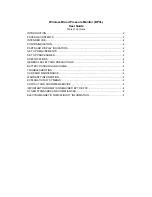
Chapter 5
Test and Measurement Functions
Channel Analyzer
Rev. 001
CX300 ComXpert Operation Manual
22130634
5 - 54
February, 2022
Window
The window setting selects the shape that is used for
processing the received signal, optimizing the signal for
different analysis functions such as more accurate amplitude,
or a lower noise floor. The main benefit of choosing the proper
analysis window is the minimization of side lobes. Select the
window according to test analysis requirements and goals.
Blackman
The Blackman window is used to minimize side-lobe level,
resulting in slightly wider central lobes and less sideband
leakage than equivalent length Hamming and Hanning
windows. The Blackman window has good characteristics
for smoothing in the frequency domain.
Flattop
The Flattop window has a better amplitude accuracy in
frequency domain and a wider frequency range when
compared to the Hanning window. However, drawbacks of
the broad bandwidth are poor frequency resolution and high
noise bandwidth. For this reason, the Flattop window is
typically used on signals with distinct, separated frequency
peaks.
Hamming
The Hamming window has a sinusoidal shape that stops just
short of zero, causing the signal to have a slight
discontinuity. The Hamming window cancels the larges side
lobe near the main lobe, but fails to address other side
lobes.
Hanning
The Hanning window has a sinusoidal shape that touches
zero at both ends, removing any discontinuity. Hanning
window is typically used when performing operational noise
and vibration measurements because it is less likely to
cause individual peaks to be lost in the spectrum.
Triangle
The Triangle window shapes the signal so that the main lobe
is twice as wide as the length of the signal without
windowing, and the first side lobe twice as far down as the
signal without windowing.
Table 5-34 Channel Analyzer Controls and Settings (Continued)
Control/Setting
Description
















































